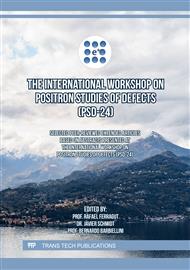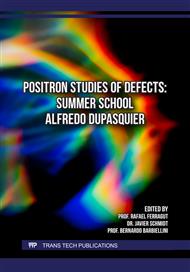[1]
R. Ferragut, Remembering Alfredo Dupasquier. AIP Conf. Proc. 2182 (2019) 020002-1-020002-5.
DOI: 10.1063/1.5135822
Google Scholar
[2]
R. Beringer, C.G. Montgomery, The Angular Distribution of Positron Annihilation Radiation, Phys. Rev. 61 (1942) 222-224.
DOI: 10.1103/physrev.61.222
Google Scholar
[3]
Positron Annihilation, in: R.R. Hasiguti, K. Fujiwara (Eds.), Proc. Fifth Conf. Positron Annihilation, Lake Yamanaka, Japan Inst. of Metals, Sendai, 1979.
Google Scholar
[4]
S. Berko, Momentum density and Fermi-surface measurements in metals by positron annihilation, in: W. Brandt, A. Dupasquier (Eds.), Positrons Solid-Sate Physics, North-Holland Publ. Co, Amsterdam, 1983, pp.64-145.
Google Scholar
[5]
K.G. Lynn, A.N. Goland, Solid. State Comm. 18 (1976) 1549-1552.
Google Scholar
[6]
K.G. Lynn, J.R. MacDonald, R.A. Boie, L.C. Feldman, J.D. Gabbe, M.F. Robbins, E. Bonderup, J. Golovchenko, Positron-Annihilation Momentum Profiles in Aluminum: Core Contribution and the Independent-Particle Model, Phys. Rev. Lett. 38 (1977) 241-244.
DOI: 10.1103/physrevlett.38.241
Google Scholar
[7]
J. R. MacDonald, K.G. Lynn, R.A. Boie, M.F. Robbins, Nucl. Instrum. Methods 153 (1978) 189-194.
Google Scholar
[8]
F. Tuomisto, I. Makkonen, Defect identification in semiconductors with positron annihilation: Experiment and theory, Rev. Mod. Phys. 85 (2013) 1583-1631.
DOI: 10.1103/revmodphys.85.1583
Google Scholar
[9]
M. Biasini, G. Ferro, P. Folegati, G. Riontino, Vacancy-solute aggregates in Al-Cu-Mg alloys studied by positron annihilation techniques, Phys. Rev. B 63 (2001) 092202.
DOI: 10.1103/physrevb.63.092202
Google Scholar
[10]
A. Somoza, M.P. Petkov, K.G. Lynn, A. Dupasquier, Stability of vacancies during solute clustering in Al-Cu-based alloys, Phys. Rev. B 65 (2002) 094107.
DOI: 10.1103/physrevb.65.094107
Google Scholar
[11]
A. Calloni, A. Dupasquier, R. Ferragut, P. Folegati, M.M. Iglesias, I. Makkonen, M.J. Puska, Positron localization effects on the Doppler broadening of the annihilation line: Aluminum as a case study, Phys. Rev. B 72 (2005) 054112.
DOI: 10.1103/physrevb.72.054112
Google Scholar
[12]
R. Ferragut, Atomic fraction around defects associated with nanoparticles in Al-Cu-Mg alloys, Physica B: Condensed Matter 407 (2012) 2676-2683.
DOI: 10.1016/j.physb.2012.02.008
Google Scholar
[13]
A. Dupasquier, R. Ferragut, M.M. Iglesias, M. Massazza, G. Riontino, P. Mengucci, G. Barucca, C.E. Macchi, A. Somoza, Hardening nanostructures in an AlZnMg alloy, Phil. Mag. A 87 (2007) 3297-3323.
DOI: 10.1080/14786430701271959
Google Scholar
[14]
R. Ferragut, A. Dupasquier, C.E. Macchi, A. Somoza, R.N. Lumley, I.J. Polmear, Vacancy-solute interactions during multiple-step ageing of an Al-Cu-Mg-Ag alloy, Scripta Mater. 60 (2009) 137.
DOI: 10.1016/j.scriptamat.2008.09.011
Google Scholar
[15]
P. Folegati, I. Makkonen, R. Ferragut, M.J. Puska, Analysis of electron-positron momentum spectra of metallic alloys as supported by first-principles calculations, Phys. Rev. B 75 (2007) 054201.
DOI: 10.1103/physrevb.75.054201
Google Scholar
[16]
R.K.W. Marceau, G. Sha, R. Ferragut, A. Dupasquier, S.P. Ringer, Solute clustering in Al-Cu-Mg alloys during the early stages of elevated temperature ageing, Acta Mater. 58 (2010) 4923.
DOI: 10.1016/j.actamat.2010.05.020
Google Scholar
[17]
G. Barucca, R. Ferragut, D. Lussana, P. Mengucci, F. Moia, G. Riontino, Phase transformations in QE22 Mg alloy, Acta Mater. 57 (2009) 4416.
DOI: 10.1016/j.actamat.2009.06.003
Google Scholar
[18]
G. Riontino, D. Lussana, M. Massazza, G. Barucca, P. Mengucci, R. Ferragut: Structure evolution of EV31 Mg alloy, J. Alloy. Compd. 463 (2008) 200-206.
DOI: 10.1016/j.jallcom.2007.09.046
Google Scholar
[19]
G. Pagot, V. Di Noto, K. Vezzù, B. Barbiellini, V. Toso, A. Caruso, M. Zheng, X. Li, R. Ferragut, Quantum view of Li-ion high mobility at carbon-coated cathode interfaces. iScience 26 (2023) 105794.
DOI: 10.1016/j.isci.2022.105794
Google Scholar
[20]
G. Panzarasa, S. Aghion, G. Soliveri, G. Consolati, R. Ferragut, Positron annihilation spectroscopy: a new frontier for understanding nanoparticle loaded polymer brushes, Nanotechnology 27 (2016) 02LT03.
DOI: 10.1088/0957-4484/27/2/02lt03
Google Scholar
[21]
F. Cavalca, R. Ferragut, S. Aghion, A. Eilert, O. Diaz-Morales, C. Liu, A.L. Koh, T.W. Hansen, L.G.M. Pettersson, A. Nilsson, Nature and Distribution of Stable Subsurface Oxygen in Copper Electrodes During Electrochemical CO2 Reduction J. Phys. Chem. C 121 (2017) 25003–25009.
DOI: 10.1021/acs.jpcc.7b08278
Google Scholar
[22]
E.V. Canesi, M. Binda, A. Abate, S. Guarnera, L. Moretti, V. D'Innocenzo, R. Sai Santosh Kumar, C. Bertarelli, A. Abrusci, H. Snaith, A. Calloni, A. Brambilla, F. Ciccacci, S. Aghion, F. Moia, R. Ferragut, C. Melis, G. Malloci, A. Mattoni, G. Lanzani, A. Petrozza, The effect of selective interactions at the interface of polymer-oxide hybrid solar cells, Energy & Environ. Sci. 5 (2012) 9068–9076.
DOI: 10.1039/c2ee22212d
Google Scholar
[23]
R. Krause-Rehberg, H.S. Leipner, Positron Annihilation in Semiconductors, Solid-State Sciences, Vol. 127, Springer, Berlin, 1999.
DOI: 10.1007/978-3-662-03893-2_4
Google Scholar
[24]
L. Chryssos, C. Hugenschmidt, Novel data analysis tool for the evaluation of Coincidence Doppler Broadening Spectra of the positron–electron annihilation line, Nucl. Instrum. Methods A 1050 (2023) 168171.
DOI: 10.1016/j.nima.2023.168171
Google Scholar
[25]
Y. Hori, Electrochemical CO2 Reduction on Metal Electrodes, in C.G. Vayenas, R.E. White, M.E. Gamboa-Aldeco, (Eds.), Modern Aspects of Electrochemistry; Springer, New York, 2008, p.89–189.
DOI: 10.1007/978-0-387-49489-0_3
Google Scholar
[26]
N.S. Lewis, D.G. Nocera, Powering the Planet: Chemical Challenges in Solar Energy Utilization. PNAS 103 (2006) 15729–15735.
DOI: 10.1073/pnas.0603395103
Google Scholar
[27]
W. Tang, A.A. Peterson, A.S. Varela, Z.P. Jovanov, L. Bech, W.J. Durand, S. Dahl, J.K. Nørskov, I. Chorkendorff, The Importance of Surface Morphology in Controlling the Selectivity of Polycrystalline Copper for CO2 Electroreduction. Phys. Chem. Chem. Phys. 14 (2012) 76–81.
DOI: 10.1039/c1cp22700a
Google Scholar
[28]
A.P. Druzhkov, B.A. Gizhevskii, V.L. Arbuzov, E.A. Kozlov, K.V. Shalnov, S.V Naumov, D.A. Perminov, Electronic and Structural Properties of Micro-and Nanometre-Sized Crystalline Copper Monoxide Ceramics Investigated by Positron Annihilation. J. Phys. Condens. Matter 14 (2002) 7981–7990.
DOI: 10.1088/0953-8984/14/34/317
Google Scholar
[29]
A. Van Veen, H. Schut, J. de Vries, R.A. Hakvoort, M.R. Jipma, Analysis of positron profiling data by means of "Vepfit". AIP Conference Proceedings 218 (1991) 171-196.
DOI: 10.1063/1.40182
Google Scholar
[30]
M. Kong, Y. Li, X. Chen, T. Tian, P. Fang, F. Zheng, X. Zhao, Tuning the relative concentration ratio of bulk defects to surface defects in TiO2 nanocrystals leads to high photocatalytic efficiency. J. Am. Chem. Soc. 133 (2011) 16414-16417.
DOI: 10.1021/ja207826q
Google Scholar
[31]
W. Brandt, R. Paulin, Positron Diffusion in Solids, Phys. Rev. B 5 (1972) 2430-2435.
DOI: 10.1103/physrevb.5.2430
Google Scholar
[32]
O.M. Osiele, D.T. Britton, M. Härting, P. Sperr, M. Topi, S.E. Shaheen, H.M. Branz, Defect structural characterization of organic polymer layers. J. Non-Cryst. Solids 338-340 (2004) 612-616.
DOI: 10.1016/j.jnoncrysol.2004.03.053
Google Scholar
[33]
S. Lotfimarangloo, H. Mahdy, P. Sau, P.A. Sterne, R.W. Gladen, J. Driscoll, M. Rooks, M. Chrysler, A.R. Koymen and J. Asaadi, V.A. Chirayath, A.H. Weiss, Measurement and analysis of the Doppler broadened energy spectra of gamma radiation originating from the annihilation of positrons incident on clean and adsorbate-covered surfaces. Appl. Surf. Sci. 689 (2025) 162372.
DOI: 10.1016/j.apsusc.2025.162372
Google Scholar
[34]
M. Zheng, I. Makkonen, R. Ferragut, J. Kuriplach, E. Laakso, V. Di Noto, G. Pagot, B. Barbiellini. First-principles study of positron interface states in graphene-stacked LiCoO2 Cathodes. Electrochim. Acta 526 (2025) 146128.
DOI: 10.1016/j.electacta.2025.146128
Google Scholar



